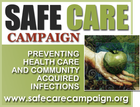Infection Prevention and Control
Our Mission
One Family, 3 Infections:
The Journey Begins
The Nahums healthcare nightmare begins at the end of 2006 when they finally come to the shocking realization that 3 family members have become infected by their medical care in 3 different hospitals in 3 different states in 10 months time.
Infection Prevention and Control Practices
for Safe Healthcare Delivery in All Settings
Introduction
Adherence to infection prevention and control practices is essential to providing safe and high quality patient care across all settings where healthcare is delivered
This document concisely describes a core set of infection prevention and control practices that are required in all healthcare settings, regardless of the type of healthcare provided. The practices were selected from among existing CDC recommendations and are the subset that represent fundamental standards of care that are not expected to change based on emerging evidence or to be regularly altered by changes in technology or practices, and are applicable across the continuum of healthcare settings. The practices outlined in this document are intended to serve as a standard reference and reduce the need to repeatedly evaluate practices that are considered basic and accepted as standards of medical care. Readers should consult the full texts of CDC healthcare infection control guidelines for background, rationale, and related infection prevention recommendations for more comprehensive information.










